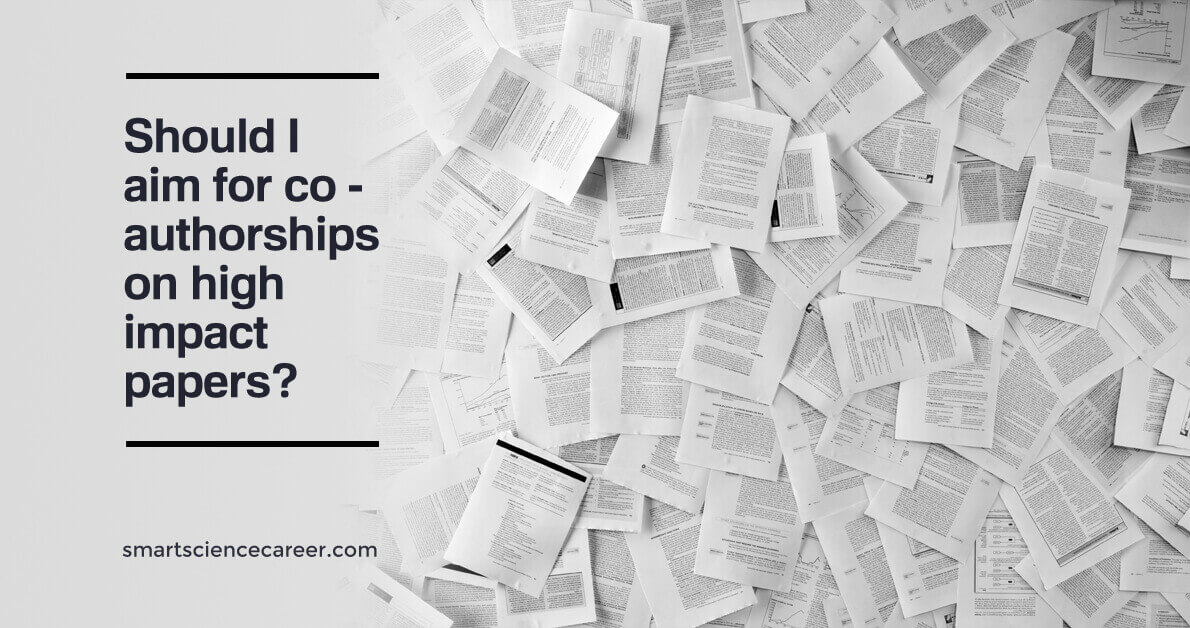Should I aim for co-authorships on high impact papers?
It is often tempting for young scientists to aim for co-authorships on papers published in journals with a high impact factor. However, is it a clever career move?
What are impact factors?
The impact factor (IF) or journal impact factor (JIF) of a scientific journal is an index calculated by Clarivate that reflects the yearly mean number of citations of articles published in the last two years in a given journal as indexed by Clarivate’s Web of Science.
Impact factors are typically used as a proxy for the quality of a journal within a specific research field.
Are high impact factors still useful parameters for a successful career in science?
For a career in science, you must know which bibliographic metrics are relevant to measure your scientific output – and why they are criticized.
There are multiple bibliographic metrics for evaluating journals and for assessing individual researchers. Impact factors, citation count, h-index, and altmetrics are well known. Other bibliographic metrics, such as the Eigenfactor, CiteScore, SNIP, FWCI, i10 index, and many more, are less well known.
Impact factors are heavily debated in science. Unfortunately, there is still no convincing alternative on the horizon.
Committees that evaluate grant proposals or select postdocs or professors still strongly base their decisions on impact factors as a proxy for scientific quality.
There are many institutions that are specifically selecting scientists that publish in high-impact-factor journals such as Nature or Science. Therefore, scientists are incentivized to increase the impact factor of your publication.
Whether high impact factors are relevant for you depends largely on your career plans
- If you want to pursue an academic career, you must aim for an ‘excellent’ publication list because one essential criterion to select professors is excellent publication output. Thus, you must develop an efficient publication strategy.
- If you want a job in the industry sector, your publication list may be useful to show your commitment and technical expertise.
- For many jobs outside academia and industry, an impressive publication list is irrelevant.
Thus, you should analyze which skills are needed in your scientific field to find your dream job in science.
Co-authorships can be very valuable – but also costly
In the companion post to this article, I have reflected upon the question whether it is clever to extend your publication list with multiple co-authorships.
I have argued that one of the best reasons to become a co-author on a paper are fruitful scientific collaborations which broaden your horizon and may give you access to knowledge, strategies, and infrastructure.
However, co-authorships can be very costly. You may have to invest a lot of time, energy and money to deliver your contribution.
Be aware that being the corresponding author does not promote your scientific career substantially.
Make sure that your input and your probable author position is clearly defined in the beginning to avoid disappointments and unpleasant discussions. It is always useful to document the agreements at least in an email.
Do co-authorships on high impact publications promote your career?
This question is difficult to answer. I had heated discussions with my colleagues on this point. My personal opinion is that one or two co-authorships on high impact publications are nice but do not help a lot because committees will always evaluate the big picture which means the entire publication list.
If the “rest is rubbish” a nice co-author paper has no value. My colleagues argue that high impact co-authorships show your connection to an excellent lab and may also help to promote further productive collaborations. Let us look at these points in more detail:
Multiple high impact co-authorships do not help when the average impact factor of the first/last author papers is low
Committee who evaluate grant proposals or select postdocs or professors will always evaluate the entire publication list. Typical questions are: How many first and last author papers has this person published? What is the MEDIAN of the impact factors? Is there a regular production of papers or are there years without a publication?
Based on my very personal experience in multiple commissions/committees I would dare to state: If most first/last author publications have a rather low impact factor this will define the evaluation of your publication list, high impact factor co-authorships will be recognized but the impact on the general judgement will be small.
Do not become the famous third author! Focus on first and last authorships
When a person has a several co-authorships on high impact publications but only a few first/last author papers there will be severe doubts about the person’s scientific independence. The advice is very clear: Focus on first and last authorships (=senior authorships).
Becoming third author on a paper can still be a lot of work. Is third author on a paper good? In my experience, third authors are treated as all the other co-authors. The only exception may be when they are awarded an asterisk indicating that they are equally contributing authors.
For PhD students, first authorships are the most relevant because at this career stage, last authorships are rather difficult to get.
For postdocs, last authorships are the most relevant because they have to demonstrate scientific independence.
Conclusion
In conclusion, I would suggest not to waste your time with high impact co-authorships when the impact factors of your first/last authorship publications are substantially lower. Focus on excellent first and last authorships (=senior authorships).
Recommended reading
The following articles may also interest you:
- What is a substantial contribution to a paper?
- 28 Tips to Get More Citations for Your Publications
- How To Write Faster: 19 Efficient Ways To Finish My Publication
- Should I have senior authorships as a postdoc?
- Should I aim for multiple co-authorships to extend my publication list?
- Should I publish negative results, or does this ruin my career in science?
- I have a fake author on my paper – what should I do?
- 10 simple strategies to increase the impact factor of your publication
- What is the best publication strategy in science?
- Corresponding author versus senior author – what is the difference?
- Is being a professor worth it?
- What is tenure?


